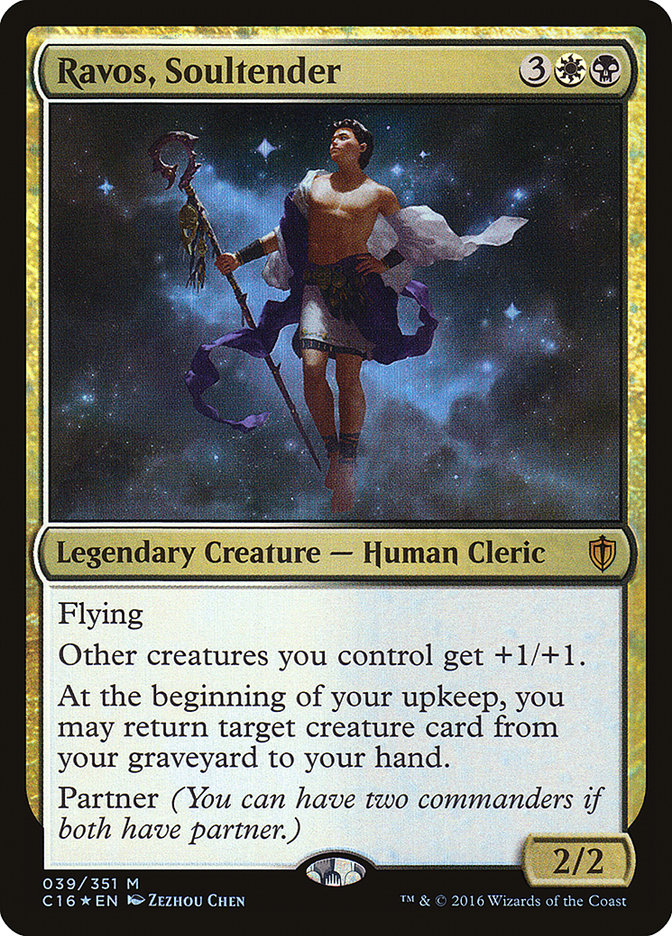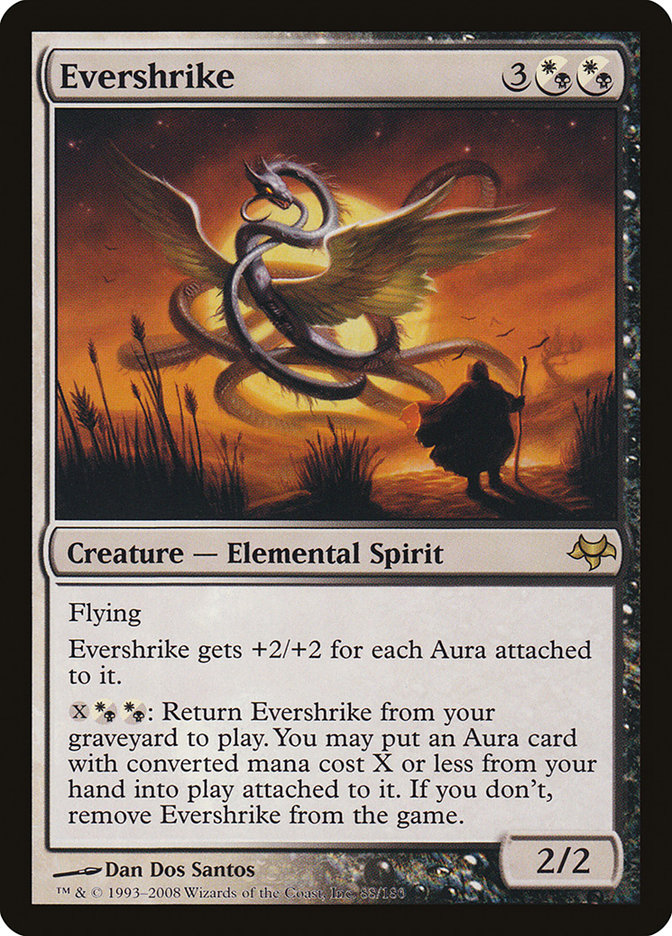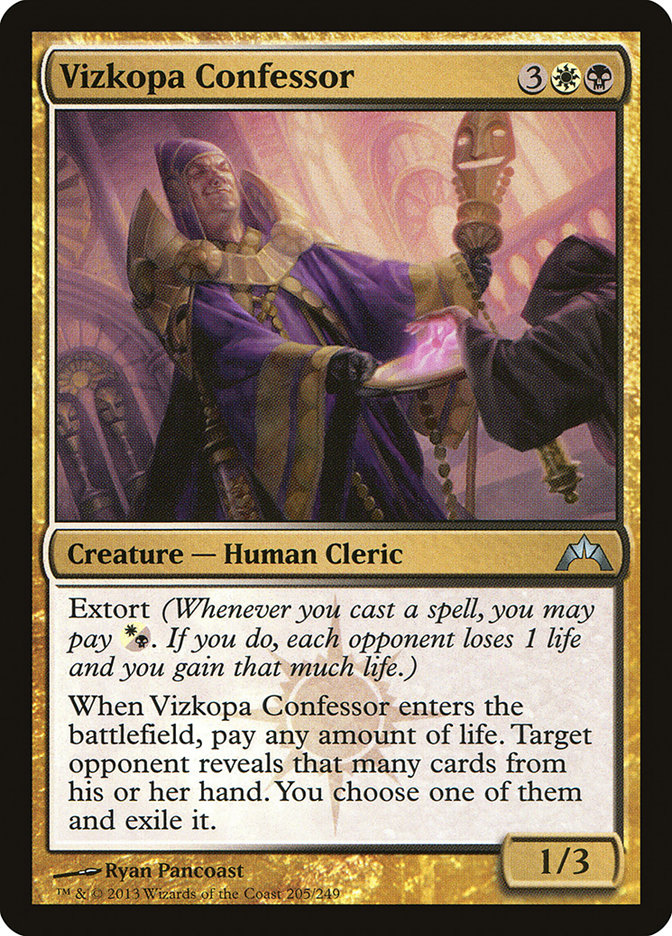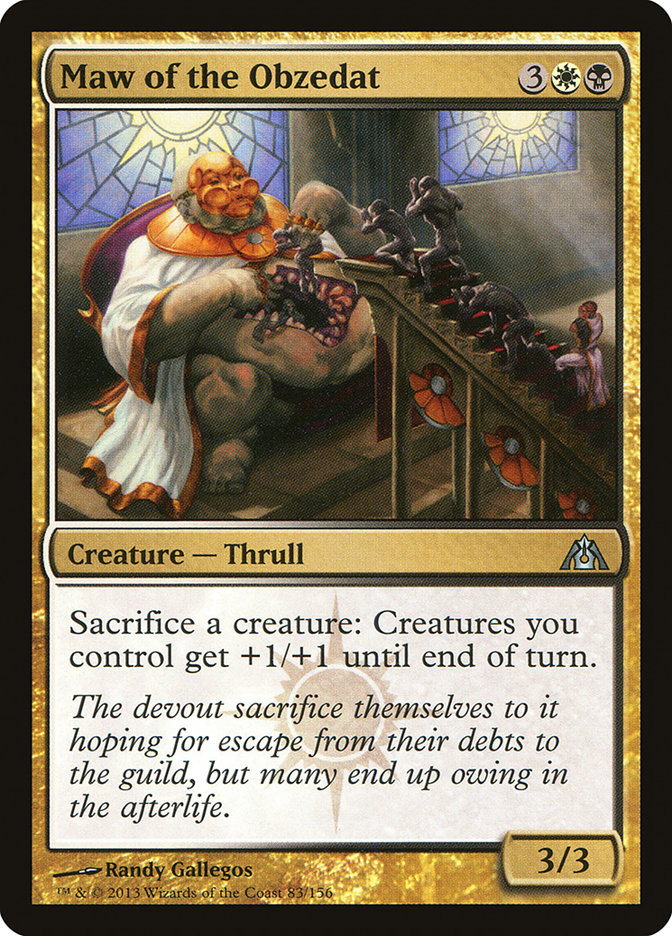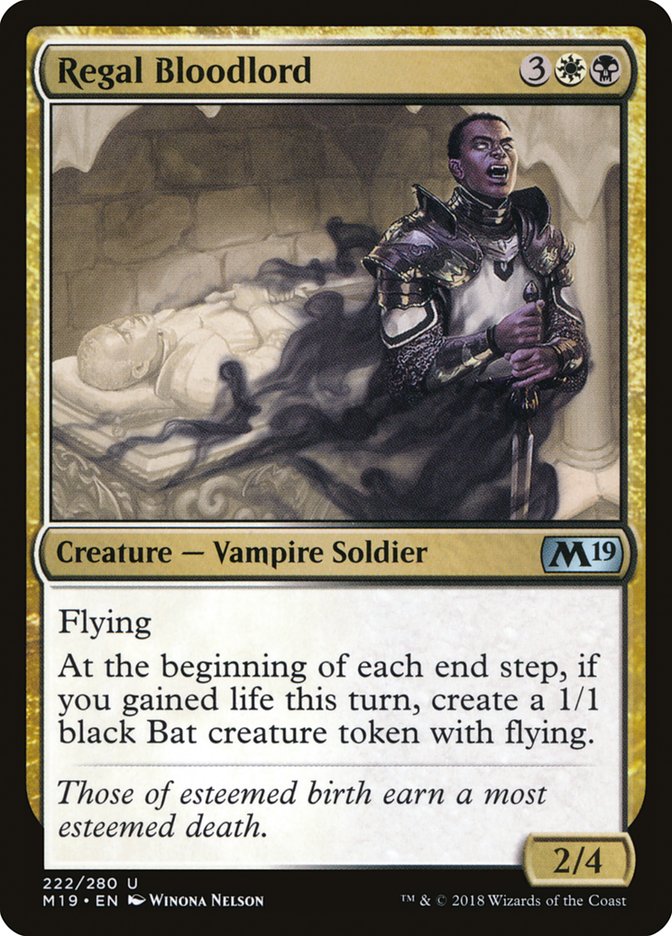Rafhos, cuidador de almas Carta MTG
| Colecciones da carta | Lanzado en 4 coleccionesVer todos |
| El coste de maná | |
| Costo de maná convertido | 5 |
| Rareza | Mítica |
| Tipo | Criatura legendaria — Clérigo humano |
| Habilidades | Flying,Partner |
| Fuerza | 2 |
| Tenacidad | 2 |
Texto de la carta
Vuela. Las otras criaturas que controlas obtienen +1/+1. Al comienzo de tu mantenimiento, puedes regresar la carta de criatura objetivo de tu cementerio a tu mano. Camarada. (Puedes tener dos comandantes si ambos tienen camarada.)
Cartas Similares
Ravos Soultender encuentra su lugar entre las criaturas legendarias en MTG que ofrecen efectos poderosos desde la zona de mando o dentro del mazo. Se asemeja mucho a Teysa Karlov, una carta que amplifica de manera similar los desencadenantes de muerte de otras criaturas. Mientras que Ravos también proporciona un impulso estático al poder de tus criaturas y la utilidad única de devolver una criatura del cementerio a tu mano durante tu mantenimiento, Teysa duplica la salida de cualquier efecto de muerte sin la recursión.
Otra carta que vale la pena mencionar en esta comparación es Karador, Jefe Fantasma. Ambos permiten jugar criaturas desde el cementerio, pero Karador te permite lanzar una cada turno directamente, evitando la necesidad de devolverla a tu mano. El beneficio de Karador radica en la inmediatez potencial y el ahorro de maná, mientras que Ravos puede ser más versátil, acumulando gradualmente presencia en el tablero y potenciando cualquier estrategia de cementerio.
En resumen, Ravos Soultender se destaca en el espectro de comandantes reanimadores, siendo atractivo por sus cualidades de fortalecimiento de criaturas y resistencia que fomentan un estilo de juego resistente y formidable en Magic: The Gathering.
Cartas similares a Rafhos, cuidador de almas por color, tipo y coste de maná
Pros de la carta
Ventaja de cartas: Ravos Soultender ofrece una forma consistente de ventaja de cartas al permitirte devolver una carta de criatura de tu cementerio a tu mano al comienzo de tu mantenimiento. Esta habilidad recursiva puede ser una gran ventaja, asegurándote de no quedarte sin amenazas y pudiendo mantener la presión sobre tu oponente.
Aceleración de recursos: Aunque la carta en sí misma no proporciona aceleración de maná directamente, la capacidad de reclamar criaturas del cementerio puede actuar como una forma de aceleración de recursos. Asegura que los recursos gastados en criaturas no se desperdicien, dándote más uso de las criaturas que ya has jugado.
Velocidad instantánea: Aunque Ravos Soultender opera a velocidad de conjuro al ser una criatura, su capacidad para facilitar interacciones a velocidad instantánea no debe ser pasada por alto. Al devolver cartas de criatura con destello o criaturas que se pueden activar o lanzar a velocidad instantánea, Ravos permite indirectamente jugadas más flexibles y sorpresivas contra un oponente.
Contras de la carta
Requisito de descarte: Ravos Soultender te obliga a aprovechar el cementerio para obtener ventaja de cartas. Esta mecánica a menudo pide a los jugadores que tomen decisiones difíciles sobre qué permanece en el cementerio en lugar de volver a la mano, lo que puede restringir el estilo de juego y la profundidad estratégica.
Costo específico de maná: Con un costo de maná específico que incluye maná Blanco y Negro, Ravos puede ser complicado de lanzar en un mazo multicolor. Esto demanda una base de maná bien ajustada para jugar la carta de forma consistente.
Costo de maná comparativamente alto: Con un coste total de cinco maná para lanzar, Ravos tiene un coste que puede dejar la carta de lado en juegos de ritmo rápido. En el meta actual, los mazos se centran en la eficiencia y a veces una inversión de cinco maná puede ser demasiado lenta, lo que la convierte en una opción potencialmente menos atractiva para los jugadores comandante que buscan un impacto inmediato en el tablero.
Razones para incluir a Ravos Soultender en tu colección
Versatilidad: Ravos Soultender ofrece un papel flexible en varios arquetipos de mazos. Su habilidad de devolver criaturas de tu cementerio a tu mano cada turno lo convierte en una pieza clave en mazos centrados en el valor, así como en estrategias enfocadas en la recursión de criaturas.
Potencial de combo: Esta carta se sincroniza bien con estrategias que se aprovechan del sacrificio de criaturas para obtener beneficios. Cuando se combina con otras cartas, Ravos puede formar bucles poderosos que pueden superar en valor y abrumar a los oponentes.
Relevancia en el meta: En un entorno de juego donde las estrategias basadas en criaturas son prevalentes, Ravos Soultender se convierte en una amenaza resistente que puede traer continuamente criaturas vitales, asegurando tu presencia en el tablero y manteniendo tu ventaja.
Cómo vencer a Ravos Soultender
Ravos Soultender presenta un desafío único en el campo de batalla con su habilidad de devolver criaturas del cementerio a tu mano en cada mantenimiento. Para hacer frente a esta recursividad se necesitan eliminaciones dirigidas o efectos de exilio. Para contrarrestar la influencia de Ravos, considera el uso de cartas como Sendero a la Nada o Espadas en Guadañas, que pueden exiliarlo directamente, evitando su tendencia a volver al campo si simplemente es destruido. Las cartas que odian el cementerio, como Descanso en la Paz, pueden detener las habilidades de Ravos al evitar que las criaturas lleguen al cementerio en primer lugar. Además, el uso de limpiadores de mesa como Ira de Dios o Condenación puede limpiar el campo mientras Ravos está activo, anulando la ventaja de la recursión de criaturas. Al centrarse en interrumpir la estrategia de acceso al cementerio, los jugadores pueden neutralizar eficazmente el impacto de Ravos Soultender y mantener el control del juego.
Recomendaciones de BurnMana
Desentrañar las profundidades de la estrategia de MTG con Ravos Soultender a la vanguardia puede ser una experiencia gratificante. Su habilidad única de recuperar criaturas del cementerio ofrece una ventaja continua, lo que la convierte en una adición valiosa para mazos que prosperan en la resistencia y la recursión. Si buscas enriquecer tu estrategia y superar a tus oponentes con una presencia continua en el tablero, Ravos puede ser la pieza angular que necesitas. Te animamos a adentrarte más en las construcciones estratégicas y descubrir cómo Ravos puede elevar tu juego. Continuemos aprendiendo juntos y aprovechemos todo el potencial de tu mazo de MTG con Ravos como guía.
Donde comprar
Si estás buscando comprar una carta MTG Ravos, Soultender de un coleccione específico como Magic Online Promos and Commander 2016, existen varias opciones confiables que debes considerar. Una de las fuentes principales es tu tienda de juegos local, donde a menudo puedes encontrar paquetes de refuerzo, cartas individuales y mazos preconstruidos de colecciones actuales y pasadas. A menudo ofrecen el beneficio adicional de una comunidad donde puedes intercambiar con otros jugadores.
Para un inventario más amplio, particularmente de colecciones más antiguos, mercados en línea como TCGPlayer, Card Kingdom y Card Market ofrecen amplias selecciones y te permiten buscar cartas de colecciones específicos. Las plataformas de comercio electrónico más grandes como eBay y Amazon también tienen listados de varios vendedores, lo que puede ser un buen lugar para buscar productos sellados y hallazgos raros.
Además, el sitio oficial de Magic suele tener un localizador de tiendas y listas de minoristas para encontrar Wizards of the Productos con licencia costera. Recuerde comprobar la autenticidad y el estado de las cartas al comprarlas, especialmente a vendedores individuales en mercados más grandes.
A continuación se muestra una lista de algunos sitios web de tiendas donde puede comprar las Ravos, Soultender y otras cartas MTG:
 COMPRAR
COMPRAR BurnMana es un socio oficial de TCGPlayer
- eBay
- Card Kingdom
- Card Market
- Star City Games
- CoolStuffInc
- MTG Mint Card
- Hareruya
- Troll and Toad
- ABU Games
- Card Hoarder Magic Online
- MTGO Traders Magic Online
Ver productos MTG
Impresiones
La carta Ravos, Soultender Magic the Gathering se lanzó en 4 colecciones diferentes entre 2016-11-11 y 2020-11-20. Ilustrado por Zezhou Chen.
| # | Liberado | Nombre | Código | Símbolo | Número | Marco | Disposición | Borde | Artista |
|---|---|---|---|---|---|---|---|---|---|
| 1 | Magic Online Promos | PRM | 86168 | 2015 | Normal | Negra | Zezhou Chen | ||
| 2 | 2016-11-11 | Commander 2016 | C16 | 39 | 2015 | Normal | Negra | Zezhou Chen | |
| 3 | 2016-11-16 | Treasure Chest | PZ2 | 59 | 2015 | Normal | Negra | Zezhou Chen | |
| 4 | 2020-11-20 | Commander Legends | CMR | 533 | 2015 | Normal | Negra | Zezhou Chen |
Legalidades
Formatos de Magic the Gathering donde Rafhos, cuidador de almas tiene restricciones
| Formato | Legalidad |
|---|---|
| Commander | Legal |
| Legacy | Legal |
| Oathbreaker | Legal |
| Vintage | Legal |
| Duel | Legal |
Reglas e información
La guía de referencia para las reglas de las cartas Rafhos, cuidador de almas de Magic: The Gathering proporciona las reglas oficiales, las erratas emitidas, así como un registro de todas las modificaciones funcionales que se han producido.
| Fecha | Texto |
|---|---|
| 10/11/2020 | Un efecto que comprueba si controlas a tu comandante se cumple si controlas uno o ambos de tus dos comandantes. |
| 10/11/2020 | Porque el daño permanece marcado en una criatura hasta que el daño es eliminado al final del turno, el daño no letal infligido a las criaturas que controlas puede volverse letal si Ravos abandona el campo de batalla durante ese turno. |
| 10/11/2020 | Ambos comandantes comienzan en la zona de mando, y las 98 cartas restantes (o 58 cartas en un juego de Commander Draft) de tu mazo se barajan para convertirse en tu biblioteca. |
| 10/11/2020 | Si algo se refiere a tu comandante mientras tienes dos comandantes, se refiere a uno de ellos a tu elección. Si se te indica que realices una acción en tu comandante (por ejemplo, ponerlo en tu mano desde la zona de mando debido a Beacon de mando), eliges uno de tus comandantes en el momento en que ocurre el efecto. |
| 10/11/2020 | Si tu mazo de Commander tiene dos comandantes, solo puedes incluir cartas cuyas identidades de color propias también se encuentren en las identidades de color combinadas de tus comandantes. Si Falthis y Kediss son tus comandantes, tu mazo puede contener cartas con negro y/o rojo en su identidad de color, pero no cartas con verde, blanco o azul. |
| 10/11/2020 | Una vez que comienza el juego, tus dos comandantes se rastrean por separado. Si lanzas uno, no tendrás que pagar un adicional la primera vez que lances al otro. Un jugador pierde el juego después de haber recibido 21 puntos de daño de cualquiera de ellos, no de ambos combinados. |
| 10/11/2020 | Para tener dos comandantes, ambos deben tener la habilidad de pareja al comienzo del juego. Perder la habilidad durante el juego no hace que ninguno deje de ser tu comandante. |
| 10/11/2020 | Puedes elegir dos comandantes con socio que sean del mismo color o colores. En el Commander Draft, incluso puedes elegir dos veces al mismo comandante con socio si los seleccionaste en el draft. Si haces esto, asegúrate de mantener claro el número de veces que los has lanzado desde la zona de mando para efectos de "impuesto del comandante". |
